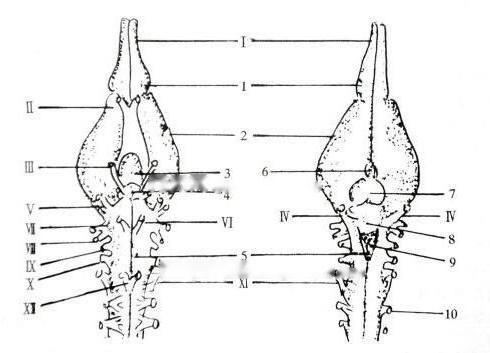Recently I read Turtle's blog, in addition to many professional turtle body structure diagrams. I think it's very useful, let's learn together.

Turtle's nervous system: 1. Olfactory lobe 2. Brain 3. Cerebral funnel 4. Subbrain gland 5. Epidermis 6. Pineal gland 7. Optic lobe 8 . Cerebellum 9. Fourth ventricle 10. Spinal nerve (Roman numeral is the ordinal number of 12 pairs of cranial nerves)
The turtle's nervous system consists of three parts: the central nervous system, the peripheral nervous system and the autonomic nervous system
Turtle's central nervous system The brain and spinal cord are the main parts of the central nervous system. Uncover the hard glans head to protect the bone. The brain tissue is regularly arranged. From the back, you can see the olfactory lobe, the pineal gland, the optic lobe, the cerebellum and the medulla oblongata. From the ventral side, the olfactory cerebellum and medulla oblongata can still be seen, as well as the infundibulum and pituitary gland.
The two hemispheres of the cerebrum of turtles are relatively developed. The hemispheres are still not clearly differentiated. The diencephalon is buried in the rhomboid-shaped recess between the cerebral hemispheres and the optic lobes. Developed to cover the back of the anterior half of the rhomboid fossa, the base of the cerebellum protrudes, flexes and extends upward into the oblongata, then flexes and extends backward and connects with the spinal cord.
The peripheral nervous system of turtles originates from the central nervous system and can be divided into spinal cord phases. The connecting spinal nerves and the cranial nerves connected to the brain 12 pairs of cranial nerves in turtles. The figure shows the order of cranial nerves in Roman numerals. The XI pair of accessory nerves have differentiated from the X pair, but the two are still connected together. Ⅻ Pair of cranial nerves enter the skull along with the occipital bone
The gray matter area of the turtle spinal cord is larger than that of amphibians, and the demarcation between gray and white matter is more obvious. However, the brachial and lumbar plexuses are slightly enlarged.
The spinal and sympathetic nerves of turtles are very developed, and their structure and arrangement are closer to higher animals than amphibians
turtles The autonomic nervous system The autonomic nervous system is the nervous system that manages the internal organs. The tissue is usually not under the jurisdiction of the will, so it is also called the automatic nervous system, also known as the visceral nervous system
![[Dog Training 5] The training method of pet dog dining etiquette](/static/img/12192/12192_1.jpg)




